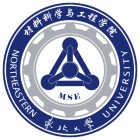
Advanced equipment and an innovative approach have led to a wide range of new metallurgy processes for high-performance materials.Credit: Northeastern University
Physical metallurgy has been central to the School of Material Science and Engineering at Northeastern University (NEU) since 1948. Traversing the frontiers of material science with a practical grasp on the latest engineering advances, the school is dedicated to fostering an innovative ecosystem, and has linked technique and equipment development with the delivery of the latest products and services.
Empowered by a multidisciplinary research culture, and an emphasis on industry-university collaboration, along with its traditional metallurgy background, the school continues to strengthen and broaden its metal materials research to include smart manufacturing of high-performance materials, environmentally-friendly steel products, light alloys, and anti-corrosion protection for metallic structures, and metallic biomaterials, catalysts and superconductors.
Great leaps for strength and durability
A research team led by NEU professor Fuhui Wang, president of the Chinese Society for Corrosion and Protection, specialises in research for marine applications. Their contributions include deep-sea polymer bonding coatings, feasibility tests on improving traditional sacrificial anodes with photocatalytic materials, and studies on extracellular electron transfer to explain the behaviours of ‘metal-munching’ microorganisms.
The team has developed other integrative coatings based on a fine balance between water resistance and lubricant friction. They have also designed anti-corrosive coatings which are electromagnetic matching and microwave absorbent. Their findings are set to significantly improve the longevity and durability of under-sea structures against their corrosion.
A track record of firsts
A new class of structure in the precipitates of magnesium alloys, an intermediary between crystals and quasicrystals, was discovered at the school. Researchers are also looking for clues as to whether the structure is found in organic and inorganic matters.
Discovery goes beyond the microscopic level in the early 2000s. Guided by grain refinement theories and thermal mechanical control processing (TMCP) technologies, the school, under the leadership of NEU professor Guodong Wang, provided the technology to mass produce the first quantity of low-cost, recyclable, high-performance ultra-fine steel, which is being used extensively in industry.
Professor Guo-Dong Wang (right), academician of Chinese Academy of Engineering and associate chairman of the Steel Rolling Institute of the Chinese Society for Metals, has contributed greatly to the study of ultra-fine steel and other metallurgical innovations.Credit: Northeastern University
Another first was its innovative heat treatment technology and equipment, which transformed the traditional production line of heavy-duty steel plates and allowed for extra thickness and width. The latest new-generation TMCP techniques and equipment upgrades produced various steel products for the construction of giant sea bridges, offshore platforms, and China’s West-East Gas Pipelines, among many other infrastructure projects.
Strip casting technology for a form of non-oriented silicon steel pioneered by the school enables high magnetic induction. Another form of silicon steel, fabricated by a comprehensive process control system, has also been developed, with the resulting silicon steel ribbons finding many uses. The ribbons were adopted nationwide for ±1100 kV direct current transmission and reduced no-load energy loss by more than 30%. The school is preparing for its next breakthrough, producing one of the world’s best-performing, high-silicon electrical steel strips of ultra-low core loss, at only 0.10-0.20mm thick.
Enhanced air and land transport
Numerous works by the school have improved vehicle design and manufacturing. The school developed a novel aluminium-silicon coating for press-hardening steels, increasing its toughness by approximate 20%. A new strengthening mechanism by nano-precipitates in high- strength martensitic steels was commercially applied in 2017 on the first batch of hot-formed steel components with a 2,000 MPa tensile strength, improving the mass production of cars significantly reduced weight.
The team has also put forth a specific acidity/pH ratio theory targeting the fabrication of chromate-free chemical conversion coatings to tackle the traditional problems of cracking due to insufficient thickness. The resultant high-quality and pollution-free coatings on magnesium alloy have been successfully applied in aerospace engineering.
Research at the school includes the microstructure refinement and composition homogeneity of oversized aluminium alloy and magnesium alloy ingots, with the help of multi-field coupling technologies. A series of ground-breaking productions, including high-performance Al alloy complex section profiles and AZ-series magnesium alloy slabs with the world’s largest cross section at 400mm × 1,450mm, accelerates the improvement of aircraft fuselage and high-speed trains manufactured in China.
Sustainable industry ecosystem
Encompassing the entire product cycle of production, supply and marketing, a unified big-data platform for managing the manifold processes, systems and fields was developed by the university and tailor-made for the iron and steel industry. It enables a cyberphysical system (CPS) framework to facilitate intelligent manufacturing, multi-process controlling and collaborative decision-making. Related intelligent control technologies are currently used on a few production lines across plants of China Baowu Steel Group, Ansteel Group, Shougang Group, among others.
As the world’s first to innovate an online cooling system for hot-rolled seamless steel tubes, the State Key Laboratory of Rolling Automation (RAL) of Northeastern University and China Baowu Steel Group have collaboratively pioneered a technique which combines online cooling control and direct quenching process.Credit: Northeastern University
The school further refines its research focus on both the theoretical and technical aspects of advanced rolling technology, metal formation and equipment, external multi-field coupling of light alloys, metallic wire preparation, material anisotropy and texture engineering, new functional materials, marine material protection, as well as integrated computational materials engineering.
The integration of physics, chemistry, information sciences, and biology will revolutionise material science, backed by the school’s effort to attract outstanding young researchers from all over the world to collaborate on its innovation.



